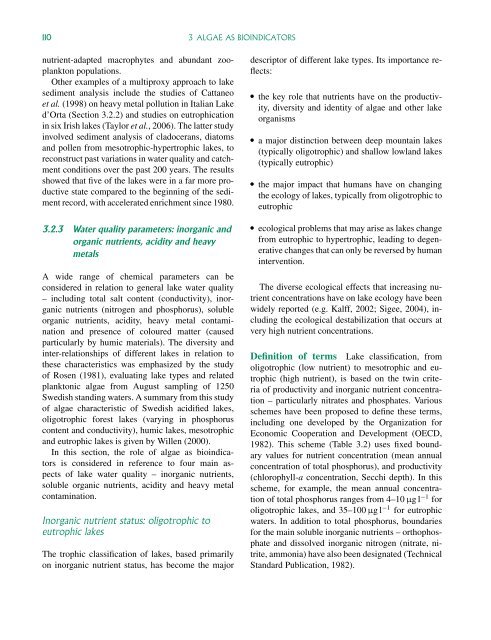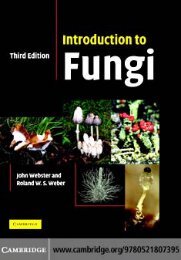Freshwater Algae: Identification and Use as Bioindicators
Freshwater Algae: Identification and Use as Bioindicators
Freshwater Algae: Identification and Use as Bioindicators
Create successful ePaper yourself
Turn your PDF publications into a flip-book with our unique Google optimized e-Paper software.
110 3 ALGAE AS BIOINDICATORSnutrient-adapted macrophytes <strong>and</strong> abundant zooplanktonpopulations.Other examples of a multiproxy approach to lakesediment analysis include the studies of Cattaneoet al. (1998) on heavy metal pollution in Italian Laked’Orta (Section 3.2.2) <strong>and</strong> studies on eutrophicationin six Irish lakes (Taylor et al., 2006). The latter studyinvolved sediment analysis of cladocerans, diatoms<strong>and</strong> pollen from mesotrophic-hypertrophic lakes, toreconstruct p<strong>as</strong>t variations in water quality <strong>and</strong> catchmentconditions over the p<strong>as</strong>t 200 years. The resultsshowed that five of the lakes were in a far more productivestate compared to the beginning of the sedimentrecord, with accelerated enrichment since 1980.3.2.3 Water quality parameters: inorganic <strong>and</strong>organic nutrients, acidity <strong>and</strong> heavymetalsA wide range of chemical parameters can beconsidered in relation to general lake water quality– including total salt content (conductivity), inorganicnutrients (nitrogen <strong>and</strong> phosphorus), solubleorganic nutrients, acidity, heavy metal contamination<strong>and</strong> presence of coloured matter (causedparticularly by humic materials). The diversity <strong>and</strong>inter-relationships of different lakes in relation tothese characteristics w<strong>as</strong> emph<strong>as</strong>ized by the studyof Rosen (1981), evaluating lake types <strong>and</strong> relatedplanktonic algae from August sampling of 1250Swedish st<strong>and</strong>ing waters. A summary from this studyof algae characteristic of Swedish acidified lakes,oligotrophic forest lakes (varying in phosphoruscontent <strong>and</strong> conductivity), humic lakes, mesotrophic<strong>and</strong> eutrophic lakes is given by Willen (2000).In this section, the role of algae <strong>as</strong> bioindicatorsis considered in reference to four main <strong>as</strong>pectsof lake water quality – inorganic nutrients,soluble organic nutrients, acidity <strong>and</strong> heavy metalcontamination.Inorganic nutrient status: oligotrophic toeutrophic lakesThe trophic cl<strong>as</strong>sification of lakes, b<strong>as</strong>ed primarilyon inorganic nutrient status, h<strong>as</strong> become the majordescriptor of different lake types. Its importance reflects: the key role that nutrients have on the productivity,diversity <strong>and</strong> identity of algae <strong>and</strong> other lakeorganisms a major distinction between deep mountain lakes(typically oligotrophic) <strong>and</strong> shallow lowl<strong>and</strong> lakes(typically eutrophic) the major impact that humans have on changingthe ecology of lakes, typically from oligotrophic toeutrophic ecological problems that may arise <strong>as</strong> lakes changefrom eutrophic to hypertrophic, leading to degenerativechanges that can only be reversed by humanintervention.The diverse ecological effects that incre<strong>as</strong>ing nutrientconcentrations have on lake ecology have beenwidely reported (e.g. Kalff, 2002; Sigee, 2004), includingthe ecological destabilization that occurs atvery high nutrient concentrations.Definition of terms Lake cl<strong>as</strong>sification, fromoligotrophic (low nutrient) to mesotrophic <strong>and</strong> eutrophic(high nutrient), is b<strong>as</strong>ed on the twin criteriaof productivity <strong>and</strong> inorganic nutrient concentration– particularly nitrates <strong>and</strong> phosphates. Variousschemes have been proposed to define these terms,including one developed by the Organization forEconomic Cooperation <strong>and</strong> Development (OECD,1982). This scheme (Table 3.2) uses fixed boundaryvalues for nutrient concentration (mean annualconcentration of total phosphorus), <strong>and</strong> productivity(chlorophyll-a concentration, Secchi depth). In thisscheme, for example, the mean annual concentrationof total phosphorus ranges from 4–10 µgl −1 foroligotrophic lakes, <strong>and</strong> 35–100 µgl −1 for eutrophicwaters. In addition to total phosphorus, boundariesfor the main soluble inorganic nutrients – orthophosphate<strong>and</strong> dissolved inorganic nitrogen (nitrate, nitrite,ammonia) have also been designated (TechnicalSt<strong>and</strong>ard Publication, 1982).
















